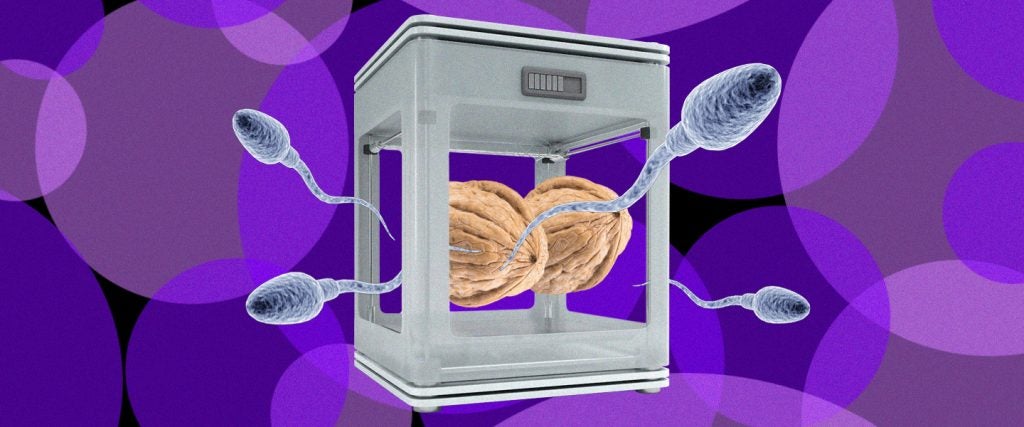April is Testicular Cancer Awareness Month, and we’re grabbing it right by the balls. Every day for the entire month, we will be publishing a new story aimed at getting men to better consider — and cherish — their family jewels in hopes of helping prevent a diagnosis that, if caught early enough, shouldn’t prove fatal. Read everything here.
You’ve heard of 3D printing. You’ve probably also learned that, if you have the money, you can 3D print basically any essential items you need: guns, chastity cages, Viagra, you name it. But what if you needed something a little more substantial — say, balls? Scientists have already started working on 3D-printed organs, like an artificial tongue that can actually taste. And now, they’ve turned their attention to baby-making.
A group of researchers at Canada’s University of British Columbia have successfully 3D-printed testicular cells, which have shown promising early signs of one day being able to produce sperm. The scientists hope that their study, published in F&S Science, will offer a future solution for men living with untreatable forms of infertility.
To make this breakthrough, the researchers performed a testicular biopsy to collect stem cells from a donor with non-obstructive azoospermia (NOA), a condition in which there’s no sperm in a person’s ejaculate. The cells were then grown and 3D-printed into “tubular structures” that resembled seminiferous tubules, the testicular tubes where sperm is produced. As reported by Science Daily, when the scientists returned to the cells 12 days after printing, they’d not only survived, but had “matured into several of the specialized cells involved in sperm production,” and were showing very early signs of having sperm-producing capabilities.
Ryan Flannigan, urology assistant professor at the University of British Columbia and lead researcher on the study, tells me that “not being able to offer patients with a lack of sperm production any therapies” was the key motivator behind the research. He explains that his team has been investigating the “underlying reasons why sperm production isn’t working in people with NOA,” but wanted to develop a platform to “test and validate the abnormalities we detect.”
“So, we looked to using 3D bioprinting as the most versatile and customizable platform to recreate the complex 3D structure of cells that we see in the human testis,” he continues.
When I ask Flannigan for more specifics on how the 3D-printing part of it works, he explains that once the cells have been grown in a petri dish — replicating from hundreds of thousands to tens of millions — they’re placed in a “special solution called ‘bioink.’” This solution supports the cells, but also has “just the right amount of thickness” to run through the printer and create the desired 3D structure of the sperm-producing tubes.
Now that the 3D-printed cells have shown positive signs of one day producing sperm, Flannigan and his team are looking to “coach” them into achieving it. To do this, Science Daily reports, they’ll “expose the cells to different nutrients and growth factors and fine-tune the structural arrangement to facilitate cell-to-cell interaction.”
If successful, the 3D-printed cells could produce sperm that could be used to fertilize an egg via IVF, proving revolutionary for individuals and couples who can’t have children. “We have a great start,” says Flannigan, “but there’s certainly more optimization and development necessary before we can apply the technology for clinical use. We have to further develop the technology to complete the process of sperm production, then, of course, obtain the appropriate safety data to ensure it’s safe and in the best interest of our patients.”
Once that’s complete, Flannigan is hopeful the technology could be extrapolated to help with other medical issues. “There are many brilliant researchers working with different diseases but toward a similar goal of regenerating function,” he explains. “One of the great things about the scientific community is that we can all learn from each other’s work, and apply successes and failures within one field to another. Hopefully, other scientists will see our results and be able to apply the pros and cons of our findings to their research.”
Here’s to the future, 3D-printed babies!

